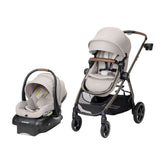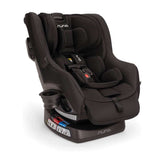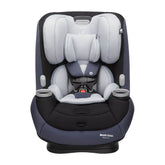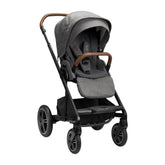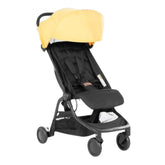How to Start Baby-Led Weaning: 6 Great Reasons to Try It

Updated 26 Dec 2024
Around six months of age, your infant’s doctor will likely mention that it’s time to begin introducing solid foods. Does the thought of trying to convince your baby to swallow mouthfuls of mushy carrot purée excite you? If not, there’s an alternative method many parents use to introduce solid foods: baby-led weaning. More and more parents are using this technique to offer their little ones developmentally-appropriate bits of food and teach them how to feed themselves.
What Is Baby-Led Weaning?
Traditionally, babies typically start their foray into solids by eating soft cereals and mashed or puréed foods. Eventually, they advance to varying textures of commercially-made baby food before progressing to solids. During this time, parents spoon-feed their infants until they’re able to manage utensils on their own.
With baby-led weaning, however, you basically skip this process. Parents watch for signs of developmental readiness and then let their little ones eat the healthy foods they want right from the start. This method lets babies learn how to gum or chew before swallowing and discourages parents from pushing food, since the baby controls what they put into their mouth.
The Mushie Silicone Baby Bib is designed for babies and toddlers to keep them comfy and clean during mealtime. Made from 100% food-grade silicone and 100% BPA, BPS, PVC and Phthalate-free materials, it provides parents with peace of mind while ensuring safe and healthy play for children, free from harmful chemicals. This bib offers a soft yet durable solution that is gentle on your little one’s skin while capturing any mess with its deep front pocket. With classic designs inspired by Swedish aesthetics, these bibs not only protect your child's clothing but also add an elegant touch to mealtime, making it both fun and stylish.
Benefits of Baby-Led Weaning
Baby-led weaning offers a number of advantages for little ones and their families.
- It’s economical. Instead of making or buying specific foods just for the baby, you’re preparing the same meal for the whole family, with modifications as needed for your little one.
- It saves meal prep time. Everyone in the family is eating the same thing so there’s less time and effort required to prepare the meal.
- It promotes variety and allows babies to try more flavors and textures. This can help them acquire more diverse, healthy food preferences as they get older. Research has demonstrated that children who consume a variety of foods also may be less inclined to develop food allergies later in life.
- It encourages fine motor skills. Encouraging your baby to use their fingers to pick up pieces of food allows them to practice hand-eye coordination and develop their manual agility.
- It may lower the risk they’ll become overweight. Spoon-fed babies don’t have much control over what or how they eat. Parents may encourage them to eat too fast or to eat more than they actually need. Baby-led weaning allows infants to self-regulate based on how hungry they feel and learn how to listen to their bodies. They don’t overeat because they’re in control of what’s going into their mouth and what they’re swallowing.
- They get to be part of family mealtime. Baby-led weaning is a great way to teach babies about family mealtime. This is an excellent opportunity for valuable social interaction within the family and allows parents and older siblings to model chewing and swallowing for babies.
When Should You Start Baby-Led Weaning?
Caregivers should look for certain signs of developmental readiness when considering when to start baby-led weaning. For most babies, these signs appear right around six months of age and include
- sitting upright unassisted
- the ability to reach for an object, pick it up, and bring it toward their mouth
- a decreasing tongue-thrust reflex (this refers to a baby’s natural urge to use their tongue to push a foreign object out of their mouth)
Babies who haven’t yet hit these milestones aren’t quite ready for baby-led weaning. It’s also worth noting that babies born prematurely may begin doing these things later than six months, so watch for these signs closer to their “corrected” age than their chronological age. The good news is that the baby-led weaning method follows and meets the needs of the individual baby, wherever they’re at, regardless of age or ability.
Keep your little one clean with the Mushie BPA-Free Non-Slip Silicone Placemat for Kids. Designed in Sweden, Mushie silicone mats pair well with our silicone bibs.
Mushie BPA-Free Non-Slip Silicone Placemat for Kids
How to Start Baby-Led Weaning
Before you decide to start baby-led weaning, read to learn as much as you can about the process and speak to your baby’s doctor. You can start the conversation around four months of age. Discuss your goals and your baby’s specific healthcare needs. Your pediatrician can go over what you need to look out for and offer additional resources that may be beneficial.
You and your child can ease into the baby-led weaning process together. For instance, you may try pre-loading a bit of applesauce onto a spoon and then giving it to them to put into their own mouth. It’s also important to let them use their hands to touch, squish, and pick up the food. Baby-led weaning is a very messy process, but a fantastic sensory experience for little ones.
Try not to stress if not a lot of food actually makes its way into your baby’s mouth at first. Learning to feed oneself takes time and practice. Besides, breast milk or formula will continue to be their primary source of nutrition through at least the first 12 months of their life.
Baby-Led Weaning Starter Foods
Slice soft foods into strips your baby can easily grasp. It should be long enough that a bit sticks out from their fist (“finger-sized”), firm enough that they can pick it up and hold it, and tender enough they can gum it. A few examples of baby-led weaning first foods include
- strips of tender, ripe fruit (mango, banana, avocado)
- spears of soft steamed, baked, or roasted vegetables (squash, sweet potatoes, carrots)
- soft shreds of meat or ground meat
Just because you’re trying baby-led weaning doesn’t mean you have to forego soft-textured foods (adults eat those, too, after all!). Plain whole-fat yogurt, oatmeal, and applesauce are all great baby-led weaning foods as well.
Foods to Avoid
Some food may pose a greater risk of becoming a choking hazard to new eaters. There are a number of foods you’ll want to stay away from during the baby-lead weaning process, including
- raw, hard vegetables (uncooked carrots; ok to offer cooked)
- round, firm-fleshed foods (whole grapes and berries; ok to offer mashed or cut into smaller pieces)
- crunchy, hard foods (corn chips, nuts, popcorn)
- peanut butter by itself (too sticky for babies to safely handle)
- honey (risk of botulism for children younger than one year)
- whole cow’s milk (ok if used in cooking, food prep, or in other dairy products, like cheese or yogurt)
The Takeaway on Baby-Led Weaning
Baby-led weaning is a great feeding technique that can give your child more independence at mealtime and possibly even help them become a more adventurous eater. Remember, though, if baby-led weaning isn’t working out for your family, that’s ok. There are many safe, healthy ways to feed your baby. Feeding techniques aren’t universal, and you don’t have to do things one particular way.

